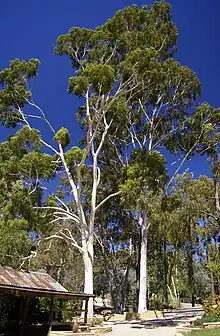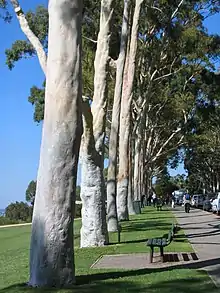Corymbia citriodora
Corymbia citriodora, commonly known as lemon-scented gum[2] and other common names,[3][4] is a species of tall tree that is endemic to north-eastern Australia. It has smooth white to pink bark, narrow lance-shaped to curved adult leaves, flower buds in groups of three, white flowers and urn-shaped or barrel-shaped fruit.
| Lemon-scented gum | |
|---|---|
 | |
| Corymbia citriodora in Wagga Wagga Botanic Gardens | |
| Scientific classification | |
| Kingdom: | Plantae |
| Clade: | Tracheophytes |
| Clade: | Angiosperms |
| Clade: | Eudicots |
| Clade: | Rosids |
| Order: | Myrtales |
| Family: | Myrtaceae |
| Genus: | Corymbia |
| Species: | C. citriodora |
| Binomial name | |
| Corymbia citriodora | |
| Synonyms[1] | |
|
List
| |

Description
Corymbia citriodora is a tree that typically grows to a height of 25–40 m (82–131 ft), sometimes to 50 m (160 ft) and forms a lignotuber. It has smooth, pale, uniform or slightly mottled, white to pink or coppery bark that is shed in thin flakes. Young plants and coppice regrowth have egg-shaped to lance-shaped leaves that are 80–210 mm (3.1–8.3 in) long and 32–80 mm (1.3–3.1 in) wide. Adult leaves are the same shade of glossy green on both sides, often lemon-scented when crushed, narrow lance-shaped to curved, 100–230 mm (3.9–9.1 in) long and 6–28 mm (0.24–1.10 in) wide tapering to a petiole 10–25 mm (0.39–0.98 in) long. The flower buds are borne in leaf axils on a branched peduncle 3–10 mm (0.12–0.39 in) long, each branch with three buds on pedicels 1–6 mm (0.039–0.236 in) long. Mature buds are oval to pear-shaped, 6–10 mm (0.24–0.39 in) long and 5–7 mm (0.20–0.28 in) wide with a rounded, conical or slightly beaked operculum. Flowering occurs in most months and the flowers are white. The fruit is a woody urn-shaped or barrel-shaped capsule 8–15 mm (0.31–0.59 in) long and 7–12 mm (0.28–0.47 in) wide with the valves enclosed in the fruit.[2][5][6][7][8]
Taxonomy and naming
Lemon-scented gum was first formally described in 1848 by William Jackson Hooker who gave it the name Eucalyptus citriodora in Thomas Mitchell's Journal of an Expedition into the Interior of Tropical Australia.[9][10] In 1995 Ken Hill and Lawrie Johnson changed the name from Eucalyptus citriodora to Corymbia citriodora.[5][11] The specific epithet (citriodora) is Latin, meaning "lemon-scented".[2]
Lemon-scented gum is also commonly known as citron scented gum, citron-scented gum, lemon gum, lemon scented gum, lemonscented gum, spotted gum[3] and lemon eucalyptus.[4]
Corymbia citriodora is similar to C. maculata and C. henryi.[2]
Distribution and habitat
Corymbia citriodora grows in undulating country in open forest and woodland in several disjunct areas in Queensland and as far south as Coffs Harbour in New South Wales. In Queensland it is found as far north as Lakeland Downs and Cooktown and as far inland as Hughenden and Chinchilla.[2][6]
Kings Park in Perth has an avenue of this species planted many years ago, but the species has spread to become an environmental weed in the Sydney and Blue Mountains in New South Wales and in open woodland areas in the south-west of Western Australia.[3][12]
Some naturalists and conservationists do not recognise the genus Corymbia and still categorise its species within Eucalyptus.[13]
Essential oil
The essential oil of the lemon-scented gum mainly consists of citronellal (80%),[14] produced largely in Brazil and China.[15] Unrefined oil from the lemon eucalyptus tree is used in perfumery, and a refined form of this oil is used in insect repellents, especially against mosquitoes. The refined oil's citronellal content is turned into cis- and trans- isomers of p-menthane-3,8-diol (PMD), a process which occurs naturally as the eucalyptus leaves age. This refined oil, which includes related compounds from the essential corymbia citriodora, is known widely by its registered tradename, "Citrepel" or "Citriodiol", but also by generic names which vary by region: "oil of lemon eucalyptus" or "OLE" (USA); "PMD rich botanic oil" or "PMDRBO" (Europe); "PMD and related oil of lemon eucalyptus compounds" (Canada); Extract of Lemon Eucalyptus (Australia). Pure PMD is synthesized for commercial production from synthetic citronellal. Essential oil refined from the leaves of the tree can contain up to 98% citronella content. The smell of the essential oil can vary, but mostly includes a strong odor comparable alone to citronella oil, with a slight hint of lemon scent.
A study comparing mosquito repellents found that products using the oil of lemon eucalyptus were effective at driving mosquitos away from a human hand.[16]
- Features of the lemon-scented gum (Corymbia citriodora)
 Bark
Bark Shedding trunk bark
Shedding trunk bark Shedding trunk bark
Shedding trunk bark Juvenile leaves
Juvenile leaves Adult leaves
Adult leaves Fruit
Fruit
See also
References
- "Corymbia citriodora". Australian Plant Census. Retrieved 2 February 2020.
- "Corymbia citriodora". Euclid: Centre for Australian National Biodiversity Research. Retrieved 5 June 2020.
- "Corymbia citriodora". Weeds of Australia. Retrieved 31 August 2021.
- "Substance information for Eucalyptus citriodora oil (oil of lemon eucalyptus), No. 800-429-0". ECHA, European Chemicals Agency. Retrieved 31 August 2021.
- Hill, Kenneth D.; Johnson, Lawrence A.S. (13 December 1995). "Systematic studies in the eucalypts. 7. A revision of the bloodwoods, genus Corymbia (Myrtaceae)". Telopea. 6 (2–3): 388–389. doi:10.7751/telopea19953017.
- Chippendale, George M. "Eucalyptus citriodora". Australian Biological Resources Study, Department of the Environment and Energy, Canberra. Retrieved 3 February 2020.
- Hill, Ken. "Corymbia citriodora". Royal Botanic Garden Sydney. Retrieved 3 February 2020.
- Nagle, Patricia. "Corymbia citriodora". Australian National Botanic Garden. Retrieved 3 February 2020.
- "Eucalyptus citriodora". APNI. Retrieved 3 February 2020.
- Mitchell, Thomas Livingstone (1848). Journal of an Expedition into the Interior of Tropical Australia. Sydney. p. 31. Retrieved 3 February 2020.
- "Corymbia citriodora". APNI. Retrieved 3 February 2020.
- Hussey et al., (1997) Western weeds : a guide to the weeds of Western Australia South Perth, W.A.: Plant Protection Society of W.A. : 1997. ISBN 0-646-32440-3, 1997
- Brooker & Kleinig (2006) Field Guide to Eucalypts. 3rd ed.
- Boland, D.J. et al., Eucalyptus Leaf Oils - Use, Chemistry, Distillation and Marketing, ISBN 0-909605-69-6.
- Lawless, J., The Illustrated Encyclopedia of Essential Oils, ISBN 1-85230-661-0
- Stacy D. Rodriguez; Lisa L. Drake; David P. Price; John I. Hammond; Immo A. Hansen. 2015. The Efficacy of Some Commercially Available Insect Repellents for Aedes aegypti (Diptera: Culicidae) and Aedes albopictus (Diptera: Culicidae) Journal of Insect Science 15 (1): 140. DOI: https://doi.org/10.1093/jisesa/iev125